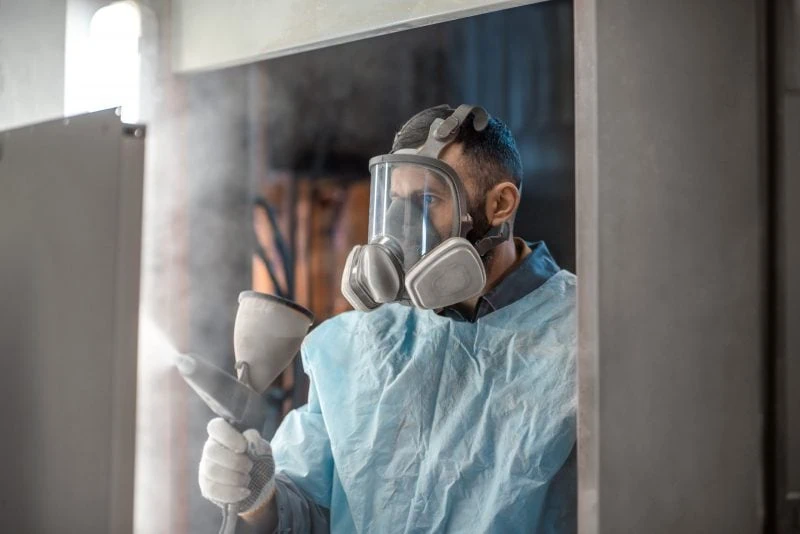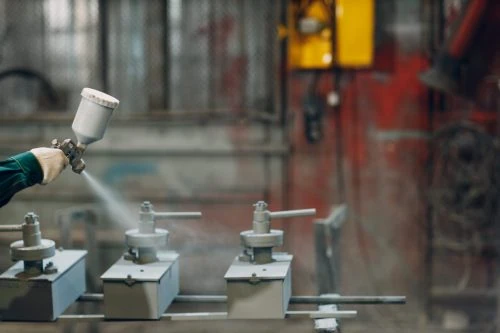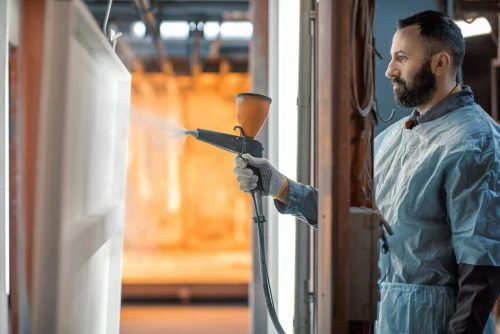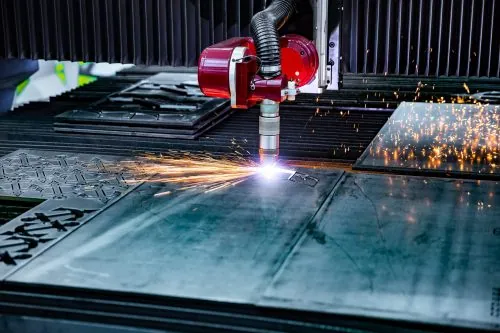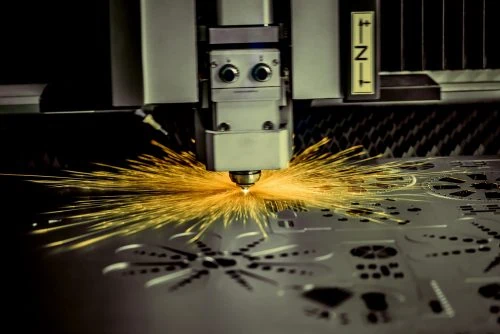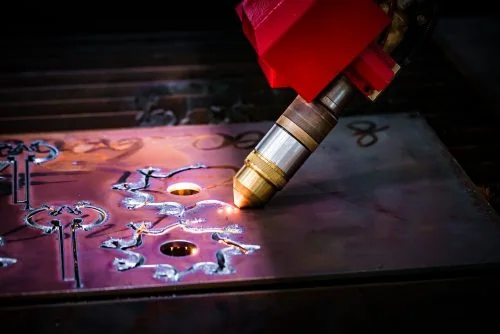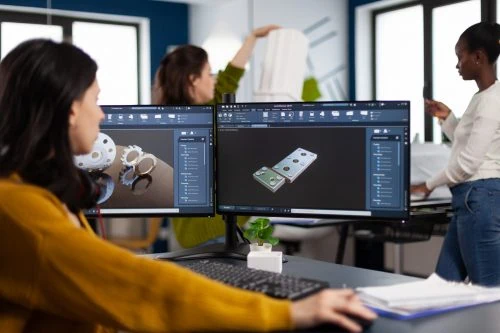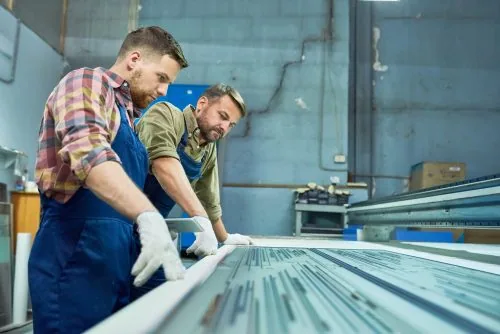When most manufacturers think of CNC laser cutters, they envision a high-speed machine designed to cut various materials into intricate shapes and parts that can work in various industries. For example, a laser cutter may be used to cut through stainless steel for appliance manufacturing or through aluminum and other delicate materials for electronics or intricate car parts.
However, an exceptional laser cutter has a lot of power beyond simple cuts. Therefore, an experienced CNC laser cutting resource can provide a wealth of services that go beyond simple metal cutting. In fact, a complete laser system can also process more intricate tasks, which include powder coating laser engraving and other processes that require a light hand.
Both laser engraving and powder coating are processes that are used for various materials and various purposes. With these techniques, a manufacturer can create branding opportunities to create high-quality, durable products that can stand the test of time (like tumblers). They also create perfect and personalized parts that align with their manufacturing goals.
From an environmentally friendly water bottle or tumbler to plastic and aluminum parts for automobiles, here’s a far-reaching tutorial on powder coating, laser engraving, and how either process can enhance your business.
What is Powder Coating?
What is the Difference Between Powder Coating and Paint?
How Does the Powder Coating Process Work with a Laser Engraver or Laser Cutting Machine?
What is Laser Engraving?
What is the Difference Between Laser Engraving and Laser Etching?
How Does the Laser Engraving Process Work?
Laser Engraving and CAD Software
A Quick Tutorial on Outsourcing Powder Coating and Laser Engraving Projects
Steelway Laser Cutting for Your Next Powder Coating or Laser Engraving Project
Powder Coating: What You Need to Know
When creating decorative and durable products, a powder coat can have a world of benefits. Typically found in modern-day tumblers, mugs, and other materials, a powder coat can expand the lifespan of a specific part or product. Additionally, they can also serve for decorative and branding purposes. A great example of powder coating in the manufacturing industry is Yeti tumblers. Not only are these tumblers renowned for their long life (which is why they typically have a higher price than an everyday mug), they are branded with a stencil design of their now world-famous logo.
Yeti tumblers, and other companies that launched similar tumbler products, first brought the power of powder coating to the surface.
Prior to the rise of these durable tumblers, most similar products featured paint images or designs, with a modest price and a limited lifespan. However, Yeti tumblers, (and other manufacturers that produced similar mugs and other tumblers) proved that there was a market for powder coated metal and other materials. The interest in powder coating grew from there across multiple sectors.
Powder coated tumblers were first introduced in the mid-2000s, and today, there is even regular media coverage (by international media outlets) on the best tumblers on the market. Therefore, while most people typically think of a durable tumbler when they think of products with a powder coat, this process can focus on a wide range of aims besides creating a great tumbler.
What is Powder Coating?
Powder coating is a finishing process where dry, free-flowing, thermoplastic, or thermoset powder coat material is applied to a material surface. This evenly applied coating is then melted and hardened into an even coat and is suitable for various materials, including metals, plastics, glass, and medium-density fiberboard (MDF).
What is the Difference Between Powder Coating and Paint?
There are key differences between powder coating and paint, starting with the application technique. The powder coating is applied via a spray to the material, and different techniques are used to stencil in a design, like masking. Then, heat is applied (via a laser system or other source) to create the finished product.
With paint-based manufacturing, only a brush is typically used to apply a stencil design or an overall coating. The paint process can certainly be automated (so the same stencil design appears on every product), and paint can also be applied to any material conducive to powder coating – like fiber, glass, metal, plastic, aluminum, and more. Both processes can be high speed and automated processes in the manufacturing industries. Additionally, they can generally suit any price range, but there are noticeable differences in the eventual coating.
In general, powder coating lasts a lot longer than paint applied with a brush or other system. Powder coating is known to be durable while still providing a pleasing aesthetic. So, when it comes to determining if powder coating or paint is right for your products (like tumblers), then powder coating tends to win over paint in terms of increasing a product’s lifespan.
How Does the Powder Coating Process Work with a Laser Engraver or Laser Cutting Machine?
The powder coating process is simple. A static charge is created, to attract very fine plastic dust media to be blown onto a material.
When it comes to stencils or other designs, there are several ways to apply variations in the coating, outside of applying paint with a brush after the powder coat has been applied. Small business owners or hobbyists using a simple laser engraving machine can use painter’s tape or masking tape to outline designs on the surface and indicate areas where the coating should not be applied.
Transfer tape or tape that applies to designs after the product is finished – can also be used to add logos and other designs after the fact. Transfer tape is generally inexpensive and easy to use. It is also a good choice for a small business or an individual using a simple laser engraving machine. (For example, transfer tape is often used to apply a design on a tumbler or other smaller drinkware product.)
Once the spray of plastic dust has been applied and any variations have been accounted for in the material design, it’s time to apply the heat. A fiber laser or other laser source can use the laser beam to provide this heat to the surface, essentially hardening the plastic dust into a durable coating. When using a basic laser engraver, adjusting the laser settings to cover a large piece of material can be a challenge. In addition, the high-precision laser settings required to etch tumblers or other materials may not be available in a basic laser engraving machine.
This is why in order to apply powder coating to large batches of materials at a high rate of speed, a CNC laser cutting service provider may be a better bet for a small business. With a high-quality laser cutting or laser engraving machine, powder coating can be applied evenly and quickly to virtually any material, from stainless steel to fiber.
In any case, once the heat has been applied and the layer of media has hardened, the final coating can be cleaned with denatured alcohol or other material for a smooth finish, and the process is complete.
Additionally, expertise is key when it comes to using a laser-oriented machine (or any machine that turns a layer of powder media into a fully set powder coating). You’ll need an exceptional laser cutting resource to assist with high quality and high-volume manufacturing projects in order to complete these projects with a lot of power and at a high rate of speed.
Laser Engraving
Laser engraving is another technique that a top-quality laser cutting service provider can power. Additionally, laser engraving is a type of metal fabrication that can be used in multiple industries to create perfectly designed and branded parts, like the automotive industry, construction industry, medical equipment and electronics industries. There are many sectors requiring a lot of power and detail.
What is Laser Engraving?
Laser engraving entails using a strong laser beam from a laser engraver or machine to vaporize metal, stainless steel, aluminum, glass, or even plastic to create indentations and intricate designs. Acting like a chisel on a sculpture, the process results in images or distinctive markings cut into metal or other materials to create a permanent design.
What is the Difference Between Laser Engraving and Laser Etching?
Laser etching and laser engraving are both popular in manufacturing industries to create logos, barcodes, stamps, and other marks. However, there is a key difference between the two processes.
Laser engraving removes a top layer of material from the surface of metal or other objects to create a design. At the same time, etching involves using the heat of a laser beam to melt a specific region of a metal surface, creating the ensuing mark.
Determining whether a material should be laser engraved or etched depends on the desired mark depth. The laser-engraved process will provide deeper indentations and marks, while the etching process will result in a small brush of a design close to the surface.
Lasers are involved in both processes (generally with a rotary attachment in simple laser engraving machines) to produce designs at a high rate of speed and with intricate focus and attention to detail.
How Does the Laser Engraving Process Work?
The laser engraving process involves the sublimation principles, where solids are rapidly transformed into a gas without passing through the intermediate liquid state. When conducting laser engraving on stainless steel, aluminum, glass, or other metal, the particles vaporize when the laser has immediate contact with the surface, revealing the engraved region.
When it comes to using a laser for engraving, three types of high-quality lasers can be used in the engraving process.
Fiber Laser
A fiber laser is ideal for metals, as a fiber laser produces a long-lasting engraving mark without interfering with the part’s inherent integrity. You’ll often find a fiber laser in producing industrial parts, but a fiber laser may not be the best bet for delicate materials like glass or plastic.
CO2 Laser
A CO2 laser can effectively engrave and cut a wide array of materials, from stainless steel to acrylic and plastic. CO2 lasers are great for manufacturers who need to conduct engraving on a wide array of materials and can power projects of all sizes. The primary drawback to using a CO2 laser to fill your engraving needs is the cost. They can be expensive to purchase in house, and a laser cutting service provider is typically a better route for laser engraving services.
Diode Laser
A Diode laser is an economical option for engraving powder coated metal and other materials that need to undergo an engraving process. Because they lack the speed and precision of higher quality lasers and laser cutting machines, they are typically used by individuals or businesses in smaller projects.
Laser Engraving with CAD Software
Regardless of which laser is used for the process, an intricate eye to design and the laser settings are required to proceed, especially when it comes to detailed images and marks. Generally, a laser engraving service provider will use computer aided design software (CAD) in order to engrave a design on metal or other material. Additionally, the engraving specifications outlined in the CAD will then dictate the laser settings.
The best aspect of the engraving process, as utilized by an experienced laser engraving provider, is that precise results can be delivered for every piece of engraved material. Once the settings are outlined in the CAD software, the laser does the rest of the work, and manufacturers can fill large orders of identical products without having to sacrifice quality or speed.
A Quick Tutorial on Outsourcing Powder Coating and Laser Engraving Projects
Regardless of whether you have products that require a powder coat, paint, or engraved images, here are a few tips to help you get started on finding a power coating or laser engraving partner.
Review the intricate details of your project.
When it comes to powder coated products or engraving, not all service providers are created equal. Some laser cutting service providers can only engrave a simple design in specified materials. In contrast, others may not have the capabilities to create powder coated products in addition to cutting and/or engraving. Make sure that you consider all aspects of your project before reaching out to a laser cutting resource. This includes anything from the images that will need to be engraved, to the varying materials, (like metal or stainless steel) that will be used now and into the future.
Make sure your provider can fill larger orders at a high rate of speed.
When it comes to powder coated or engraved materials, you’ll need quality as well as quantity to fill your orders to your exact specifications. Ask your service provider for a precise timeframe and overall estimate to ensure a delay doesn’t slow down your business operations.
Make sure that your provider has the best technology available.
Precise and advanced laser machines and settings are required to engrave a material to exact specifications or to efficiently spray material to create a perfect powder-coated product. You’ll want to ensure that your partner uses the best lasers to perform the work and has experts on hand to take care of the intricate details.
For Your Next Powder Coating or Laser Engraving Project – Your Only Solution is With Steelway Laser Cutting
At Steelway Laser Cutting, we have the expertise, tools, and experience required to tackle all sorts of manufacturing projects. These include powder coated products like tumblers or engraved parts like automotive parts.
Your next big project can be simplified, cost-effective, and performed to precise and exceptional results, and it starts with a quote and a consultation from Steelway Laser Cutting.
Reach out to us today for a tutorial on how our laser cutting services can be utilized for your powder coating or engraving projects, as well as any other manufacturing needs you may have on the horizon.
With Steelway Laser Cutting as your backbone resource, you can engrave, create powder coated products, and effectively tackle any project your company requires to reach new levels of success.
